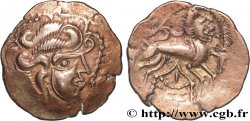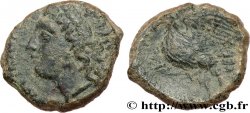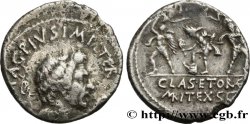bga_975890 - GAULE, UNSPECIFIED Statère de Philippe II, imitation celtique type de “Montmorot”
4 500.00 €
Quantità
Aggiungi al carrello

Tipo : Statère de Philippe II, imitation celtique type de “Montmorot”
Data: IIIe siècle avant J.-C.
Metallo : oro
Diametro : 19 mm
Asse di coniazione : 7 h.
Peso : 8,33 g.
Grado di rarità : R3
Commenti sullo stato di conservazione:
Beau statère bien centré des deux côtés. Portrait de style fin au droit, bien venu à la frappe. Un petit coup est à noter à huit heures au droit, ainsi que sur l’aurige au revers. De fines rayures
N° nelle opere di riferimento :
Pedigree :
Avec son certificat d’exportation n°249037 délivré par le Ministère français de la Culture
Diritto
Titolatura diritto : ANÉPIGRAPHE.
Descrittivo diritto : Tête laurée à droite, imitant la tête d’Apollon.
Rovescio
Descrittivo rovescio : Bige galopant à droite, les chevaux bondissant ; l'aurige, au-dessus de la roue du char, tient un fouet ; monogramme AP sous les chevaux.
Legenda rovescio : fILIPPoIU
Traduzione rovescio : ( de Philippe).
Commento
Ce statère est une dégénérescence du type d'Abydos, avec l'épi de blé en différent au revers (hors flan sur la grande majorité des imitations gauloises). L'attribution aux Helvètes est possible, mais pas certaine, pas plus que celle aux Arvernes ou bien encore une hypothétique attribution aux Carnutes. La concentration des trouvailles, pourtant dispersées, serait plutôt dans l'est de la France.
This stater is a degeneration of the Abydos type, with the ear of wheat different on the reverse (except on the flan on the great majority of Gallic imitations). The attribution to the Helvetians is possible, but not certain, no more than that to the Arverni or even a hypothetical attribution to the Carnutes. The concentration of finds, although dispersed, would rather be in the east of France
This stater is a degeneration of the Abydos type, with the ear of wheat different on the reverse (except on the flan on the great majority of Gallic imitations). The attribution to the Helvetians is possible, but not certain, no more than that to the Arverni or even a hypothetical attribution to the Carnutes. The concentration of finds, although dispersed, would rather be in the east of France








 Segnalare un errore
Segnalare un errore Stampate la pagina
Stampate la pagina Condividi mia selezione
Condividi mia selezione Fai una domanda
Fai una domanda Consegnare / vendere
Consegnare / vendere
 Descrittivo
Descrittivo











